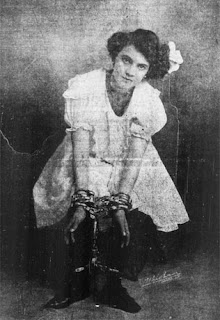Ybur
 |
| Daily Huonite, June 2 1909 Huron, SD |
Ybur, her real name is sadly unknown, was reportedly from San Francisco, California. She said she started her career there when a local manager helped her develop the act. In a later interview, Ybur mentioned a handcuff dive off the Washington Street dock into San Francisco Bay. When Ybur swam to shore she was immediately arrested for attempted suicide. However, the theater manager quickly explained to the police that it was a publicity stunt. This escape or her performances in San Francisco could not be verified.
The tour probably started in California and traveled up the coast. A newspaper article published later in her tour stated that the Portland, Oregon papers reported she was handcuffed, placed inside of a large fish cask, the bungs knocked out and the barrel dropped from a bridge into the water. The barrel quickly sank, but Ybur escaped and swam to a nearby tug amid shouts from the large crowd assembled on the bridge. While a great-sounding escape, I could find no references to it.
The first part was challenge handcuff escapes. She would try and have members of the local police force restrain her with their handcuffs and shackles. She also invited local citizens to provide restraints. In her performance in Iowa City, students from the University of Iowa collected all the handcuffs and shackles they could find and bound her with them. Ybur released herself within three minutes, which led to much excitement and publicity.
The second part of the act was either the milk can, straight jacket or trunk escape. Sometimes Ybur would perform the milk can and one of the other escapes during each performance. Newspaper reviews said that many stayed through both performances to see the milk can again. This escape is what brought in the crowds.
 |
| Red Bluff Daily, May 2, 1916, Red Bluff, CA |
 |
| Front Page San Francisco Call, June 21, 1911 |
Ybur spent the next several months recovering and rebuilding the act. In December she was back on the road performing her standard act in Richmond, California. While it was announced she would leave for a tour of the east coast tour, Ybur stayed in California and performed mainly around San Francisco and Los Angeles until early 1913. When she seems to have retired the escape act.
However, in early 1916 she revived her old act, this time with a specific goal in mind. She toured the west coast with great success until late spring. Then in June, it was announced she had bought a new Curtiss biplane and was arranging to fly at fairs in the fall. Aerial Age Weekly wrote that Ybur was the first female pilot to offer her services to the Army’s flying squadron. In December 1916 she was giving demonstrations, under the name Ybur Osborne, at Harvey Crawford’s Aviation School in Phoenix, Arizona. Crawford was a well-known barnstormer, instructor, airplane designer and builder based in California. He came to Phoenix a couple of months before to perform at the Arizona State Fair and stayed to start a flying school. Crawford may have been Ybur’s flying instructor. The school was not a success and soon he returned home. After this nothing is heard from Ybur.
 |
| Billboard, Dec 16, 1916 |
 |
| Daily Huronite, June 2, 1909, Huron, SD |
Daily Huronite, June 1-2, 1909, Huron, South Dakota
Vancouver Daily World, December 1, 1908, Vancouver, British Columbia
Helena Independent Record, February 28, 1909, Helena, Montana
Helena Independent Record, March 3-4, 1909, Helena, Montana
Helena Independent Record, March 9, 1909, Helena, Montana
Muscatine Journal, January 4, 1911, Muscatine, Iowa
Chronicle-Telegram, December 13, 1910, Elyria, Ohio
Red Bluff Daily News, May 2, 1916, Read Bluff, California
San Francisco Chronicle, April 18, 1911, San Francisco, California
Variety, May 20, 1911, New York, New York
Modesto News, June 21, 1911, Modesto, California
The San Francisco Call, June 21, 1911, San Francisco, California
San Mateo Times, June 24, 1911, San Mateo, California
Variety, July 1, 1911, New York, New York
Billboard, December 2, 1911, Cincinnati, Ohio
Marin County Tocsin, January 11, 1913, San Rafael, California
Oakland Tribune, February 7, 1916, Oakland, California
Evening Herald, May 10, 1916, Klamath Falls, Oregon
Billboard, June 24, 1916, Cincinnati, Ohio
Aerial Age Weekly, July 24, 1916
Arizona Republican, October 18, 1916, Phoenix, Arizona
Billboard, December 16, 1916, Cincinnati, Ohio
Arizona Republican, July 8, 1917, Phoenix, Arizona
(references are in order they were first used)
Gary Hunt Copyright 2018



Comments
Post a Comment